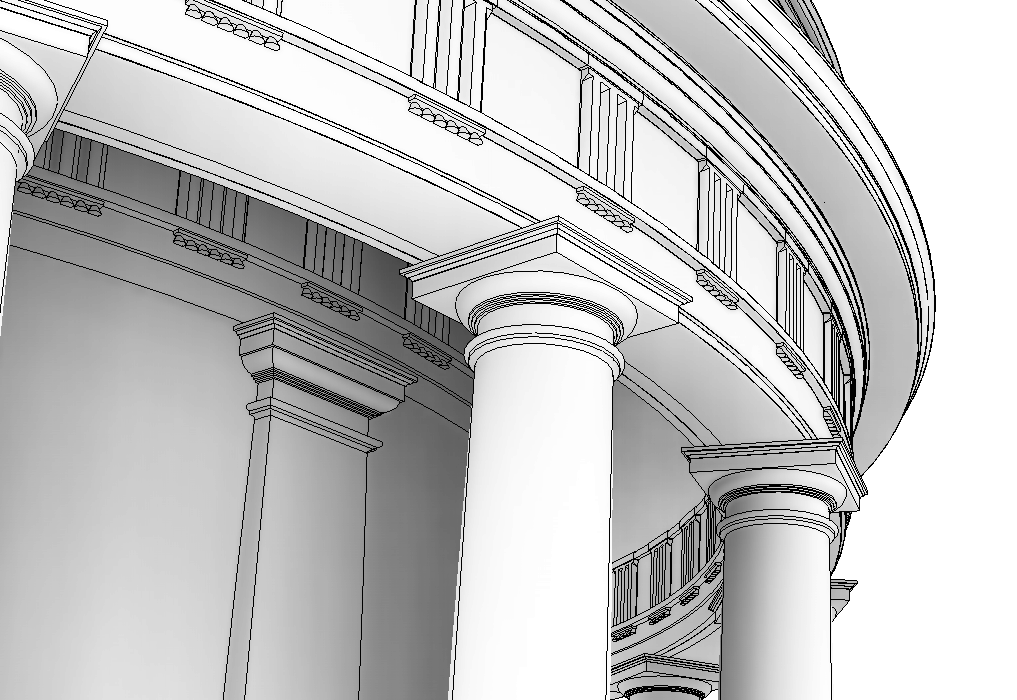
First… Why hire an Architect?
Why Does The AIA Say You Should Hire An Architect?
What do Architects do? And how can they help you?
Why hire an Architect? Few people realize how complicated it is to build-that is until they find themselves lost in a maze of design options, building codes, zoning laws, contractors and so on. No two building projects are exactly alike, so there is no single clear-cut path to follow. Whether you’re about to expand your current facility, adapt an existing structure to a new use, or construct an entirely new building, your building project represents a major investment that will affect the productivity and efficiency of your organization for years. Smart decision-makers know that the way to maximize such an investment begins with consulting an architect. Architects are the only professionals who have the education, training, experience and vision to maximize your construction dollar and ease the entire design and construction process.
Early involvement is key. By helping you define the building project, architects can provide meaningful guidance for design. They can conduct site studies, help secure planning and zoning approvals, and perform a variety of other pre-design tasks. Plus, when architects are involved at the earliest planning stage, they gain more opportunities to understand your business, develop creative solutions, and propose ways to reduce costs. The long-term result is a facility that adds to the productivity, efficiency, and effectiveness of your operation.
(Why hire an architect? Speak with an architect who is a member of The American Institute of Architects (AIA) at the earliest stage of your planning process).
Second. And the reason you are here in the first place…
What are the Top 5 Reasons to Fire Your #Architect?
Q. Are you an architect? Have you ever hired an Architect?
Why Hire an Architect
|
American Institute of Architects, architects, builders, CFA, Consulting For Architects, contractors, David McFadden, do not hire an architect, do you need to hire an architect, hiring an architect, jobs, jobs for architects, recession's affect on architecture, reddit, staffing, Staffing for Architects, unemployed architects
|

Recruiter Kristi Enigl
 Consulting For Architects, Inc. (CFA), a leading staffing firm for the architecture and interior design industry since 1984, announced today the hiring of Recruiter Kristi Enigl located in the New York office.
Consulting For Architects, Inc. (CFA), a leading staffing firm for the architecture and interior design industry since 1984, announced today the hiring of Recruiter Kristi Enigl located in the New York office.
Consulting for Architects (CFA) is pleased to welcome its newest member, Recruiter Ms. Kristi Enigl. CFA has been recruiting talented architects and interior designers since 1984 and placing them in long-term roles with top architectural and design companies throughout the United States. Their latest team member, Ms. Enigl, holds a Bachelor of Arts in Telecommunications from San Diego State University, and for the past two decades has served as senior recruiter and account manager, HR manager and career consultant for staffing firms and architectural companies alike.
For the original version on PRWeb visit here.

Author: Lindsay Van Thoen December 20, 2013; for the Freelancers Union
What happens when you tell someone you’re a freelancer?
In my experience, you’ll probably get some version of the following:
1. “I wish I could work in pajamas and sleep in every day!”
There may be some freelancers who don’t have to leave their house, spend their days watching Mad Men reruns, and only work 4 hours a day — but honestly, I haven’t met one yet.
Most freelancers are too busy going to client meetings, meeting with prospective clients, working out of the client’s office, going to networking events, working around their families’ schedules, and, you know, running their own business.
The idea that freelancers are sloppy and carefree somehow implies that freelancers just don’t work as hard as 9-5-ers. Not true!
2. “Ugh, the economy is so tough.” (I.e., freelancing is not a real job or people are only freelancers because they can’t find a real job.)
While it’s true that many traditional workers didn’t start freelancing by choice, it doesn’t mean that freelancers are poor, miserable souls who can’t wait to crawl back to corporateville.
Many freelancers either go independent by choice or find they like freelancing better, whether it’s because of more autonomy or better work/life balance or a host of other reasons that don’t involve desperation and agony.
It’s true that freelancing still doesn’t have the status of a C-level position in most fields. I expect that as more workers go freelance, a more realistic perception will develop: there are bad freelancers and good freelancers, happy freelancers and miserable freelancers, experienced and inexperienced.
We’ll soon see workers as whole people with a set of skills and services, not as the position they’re in.
3. “It must be so nice to never have anyone order you around!”
Wouldn’t it be great if this were true?
It’s true that freelancers are their own bosses — but sometimes, to maintain a good client-freelancer relationship, you have to let the client have what they want.
The best clients do say: “Here is the task I want, here are my expectations, I trust you to complete it well.” There are also clients who micromanage you the whole way. And a whole host of other people who think “freelancing” means “lowest rung on the totem pole that I can treat any way I want.” This is where freelancers have to educate clients about proper relationships and expectations.
4. “You must always have such exciting work!”
One of the best things about freelancing is that, to a certain extent, you get to choose the projects you’ll work on. If you work in a creative field, you’ll also be able to develop your own unique style/niche/speciality, so that people who come to you want YOU, and let you be your whole self.
But there are going to be boring days. There are going to boring projects or boring revisions or boring accounting.
Also, some freelancers are happier doing work they’re good at for steady clients than having constant new/exciting projects. They love the time they have with their family and they love the flexibility more than they love every single project they work on.
5. “Freelancers pad their invoices — you can always get them to negotiate down their fees.”
You probably won’t hear anybody say this to your face, but they will say it behind your back!
First, many freelancers are actually undercharging for their services. That’s because many people who go into freelancing assume that they should charge the hourly rate they got when they were an employee.
No. You need to charge that hourly rate, plus what you used to get for benefits that you now have to pay for yourself (~20-30%), plus an estimate of how much time it takes to land the client and ancillary things (like invoice filling), plus any equipment costs (like computers). This is an accurate representation of your value, not padding.
Freelancers who undercut the market rate hurt all freelancers and set expectations for cheap work.
6. “I could never freelance — I have too many financial obligations. It’s so insecure!”
The truth is that every job is insecure. Markets change, companies close or downsize.
The only security you have is the ability to provide a service of value that someone is willing to pay for. Your security is you. This isn’t a mindset, it’s a set of actions — all of which are easier said than done.
Smart freelancers make themselves recession-proof by having multiple income streams, constantly marketing themselves and forming new connections, and staying flexible by learning new skills, new programs, new fields.
When the economy leaves a smart freelancer in the lurch, he/she can pivot skills or rely on another income stream. Traditional employment can give one the illusion of stability, and that in itself is pretty risky!
What other myths about freelancing have you heard?

Author Paul Aubin’s latest book: Renaissance Revit: Creating Classical Architecture with Modern Software was published this week. Paul Aubin is a well-respected author of dozens of books on Building Information Modeling using Revit and other Autodesk software. His latest book tackles a subject never before approached in the world of Revit training manuals. In this exquisite hands-on guide, Paul Aubin walks you through two of his passions; Revit and Classical Architecture for the price of one. Take a virtual tour through the history of architecture in a way like no other. Paul Aubin’s book is a tutorial of epic proportions that does not just talk about creating Doric, Ionic and Corinthian columns; it walks through the process step-by-step! Following along with Paul as your guide, at the end of this book you will have built four of the five classical orders.
The steps are easy to follow for both veteran Revit users and novices alike. You’ll begin by learning the basics required to successfully create robust and fully parametric Revit family content. Next you’ll apply what you learned by building a simple schematic version of a Tuscan column. This will become a coarse detail version in later lessons and becomes what Paul refers to as the “seed” for future families. Each chapter is packed with useful tips that apply not just to creating classical architectural forms, but any Revit family. In fact, that is what makes this book so powerful. It is cloaked in classical architecture, but at its core it is the ultimate family editor’s guide to Revit content creation. The classical families just make for a really fun way to learn about Revit content creation. And of course, if your work does involve the classical orders, then you come away with some very useful examples at the end of the book.
Each chapter builds on the previous as you learn to control complex forms and shapes in a fully flexible and parametric way. Take these forms and create reusable components such as profiles and family seeds. As the chapters unfold, you take a journey through history as the orders become progressively more complex: Tuscan to Doric, Doric to Ionic and culminating in a fully parametric Corinthian capital.
We highly recommend Author Paul Aubin’s new book. It is of particular interest to anyone interested in Revit family creation. The book is available in two editions: black and white and a stunning full color edition. The full color one comes at higher cost, but is easy to justify given how much better the book’s numerous illustrations pop off the page in full color. So don’t hesitate, jump over to Paul Aubin Website today to learn more and order your copy!
Paul has been active in the architectural community for nearly 25 years. Paul Aubin is a former Consulting For Architects, Inc. (CFA) employee living in Chicago. Paul Aubin and had the pleasure of working together from March 1996 – March 2004. As a CFA employee Paul Aubin was instrumental in developing and teaching Autodesk© AutoCAD© and Revit©, BIM to 100’s of architects and designers at CFA’s Autodesk ATC©, and developing CFA’s CAD test – known as CFAeX Knowledge Assessment Tools

The entire CFA team and I are pleased to announce the completion of the rebranding of our company, social sites, and website. We wanted a fresh new look that better reflects our times and services in a constantly changing world and the professionals we represent. I described CFA to as a 29 year old “start-up” because we have always reacted well to change and our brand should reflect our unique ability and staying power. CFA was successful the year it was created, 1984, and has never looked back.
Special thanks and acknowledgement goes out to our designer Ryan Kovich. Ryan devoted several months of his valuable time and energy studying the creative world of architecture and design and contemplating our brand identity. He took that knowledge and his creative energy to bring us this great new brand. Find Ryan Here.
We would also like to thank our creative editor David Gibbons. David did a tremendous job taking our ideas, filtering out the rhetoric, and providing rock solid content that expresses our brand perfectly. Find David Here.
Finally, we would like to thank our consultants and clients who gave us their valuable input throughout this process. Our rebranding efforts success would not be possible without them.
Would you like to evaluate our new Website? Evaluation Form.
CFA Services
|
aia, Architect, architects, Architectural History, architecture, Architecture Commentary, Architecture Critic, Architecture Design, architecture jobs, Art, Art and Culture, BIM, buildings, Built environment, CAD, carbon-neutral office building, CFA Freelancer Community, CFA Services, Construction, Consulting For Architects, container architecture, Corporate responsibility, David McFadden, design, Design News, Design Technology, eco building, Employment Advice, Employment News, Engineering, Featured Architecture + Design Blog, Featured Projects, Freelancer tips, government architecture, Green Architecture, green building, Uncategorized
|
As the owner of Consulting For Architects, I have had the opportunity and privilege to work with the architecture firm, Gwathmey Siegel from the mid nineties to present as a provider of staffing services. Mr. Gwathmey’s passing is a loss for his family, friends, firm and the profession and I hope to bring together some of the things others have said about him recently in regards to his passing.
From the New York Times:
Charles Gwathmey, part of a generation of architects who put their own aesthetic stamp on the “high Modernist” style, died on August 3. He was known both for residential work — he built living spaces for Steven Spielberg, David Geffen and Jerry Seinfeld — and sometimes controversial public buildings.

In the New Yorker Magazine architecture critic Paul Goldberger said:
Postscript: Charles Gwathmey
In 1965, Charles Gwathmey, three years out of the Yale School of Architecture, designed a house and studio for his parents, the artists Rosalie and Robert Gwathmey, on Bluff Road in Amagansett, on eastern Long Island. Gwathmey was twenty-eight, an age when most architects are toiling away in large corporate offices and hoping for the chance to renovate a friend’s kitchen. When Gwathmey’s project, a pair of crisp, sharply angled structures covered in cedar siding, was finished, a year later, it became one of the most influential houses of the decade: a composition of cubes, cylinders, and triangles, it was a study in inventive modernist geometries. It cost somewhere around thirty-five thousand dollars, and it inspired a generation of beach houses in the Hamptons and elsewhere.
Architectural careers generally develop slowly, which made Gwathmey’s particularly unusual, the architectural equivalent of the young writer who comes out of nowhere and produces a brilliant first novel. In some ways, Gwathmey was the architecture world’s Norman Mailer, with the same bravado, the same raw talent, and the same career-long anxiety about whether he could continue to equal his spectacular first performance. Over the years, Gwathmey’s work became more complex than the house and studio in Amagansett, and vastly more elaborate. The cabinetry in any Gwathmey kitchen was certain to cost several times as much as his parents’ entire house.
A few years after the house in Amagansett was finished, Gwathmey and his architectural partner since 1968, Robert Siegel, designed an apartment at the El Dorado, on Central Park West, for Faye Dunaway, and over time they became the architects of choice for clients in the entertainment industry who were sophisticated enough to want something other than an interior decorator’s French Provincial. The firm of Gwathmey Siegel designed modernist houses and apartments for David Geffen, Steven Spielberg, Jerry Seinfeld, Jeffrey Katzenberg, Ron Meyer, and Frank Marshall and Kathleen Kennedy, not to mention grandiose modernist villas for Michael Dell, the computer maker, and Mitchell Rales, a Washington, D.C., industrialist, for whom Gwathmey also designed a private museum, Glenstone.
By the time the large villa that Gwathmey had designed in East Hampton for François de Menil, now owned by Larry Gagosian, was completed, in 1983, it was clear that Gwathmey had become not the avant-garde architect that his early success had promised but something closer to a modernist Stanford White or John Russell Pope. Gwathmey’s modernism, by then, had become not so different from what a Georgian manse was in the nineteen-twenties: a symbol of refinement and sophistication more than of cutting-edge sensibility. Maybe it didn’t matter: after all, his houses were impeccably designed and exquisitely crafted, and his clients were not just any rich people but ones who knew the difference between a Gwathmey house and someone else’s.
Still, Gwathmey hated to be thought conservative, and the unspoken theme of his career was the struggle between his desire to continue to make buildings that were new and different and his passion for a kind of classic modernism, which as time went on seemed ever more to be a part of history. He never copied anything literally, and he couldn’t bear to think of himself as one of those architects who replicate the past. He kept trying, over and over, to find new ways to rearrange the basic geometric shapes he loved so much—he was earnest, almost innocent, in his passion for pure architectural form—and his late work, if not dazzling in the way that his parents’ house was, had a striking richness to it. He tried new surfaces, he tried new materials, he tried new shapes, but there was always the same kind of sleek, crisp formality to his work. If there is such a thing as blunt intricacy, Gwathmey’s architecture has it.
He was at his best at small scale, which made him the opposite of almost every other major architect of our time. He did a few towers, none of which were great, and several institutional buildings, few of which equalled his best houses. (He was almost alone among first-class architects in making houses a central part of his practice, even when he had plenty of bigger, more lucrative projects.) Toward the end of his career, he poured his heart and soul into a non-residential commission he cherished, the restoration and expansion of the Art and Architecture Building at Yale, by his teacher Paul Rudolph. The Rudolph building is an impossibly difficult neo-Brutalist masterpiece from 1963, and Gwathmey made it look better than it has in forty years. His addition is smart and well planned on the inside, and too complex and overwrought on the outside. It tells you all you need to know about its architect, who couldn’t bring himself to sit quietly beside his mentor. Gwathmey paid loving homage to Rudolph in the restoration, and then he wanted to get into the ring with him. I don’t think he was trying to show his teacher up. He just worried about what it would look like if he didn’t assert himself. He never wanted anyone to think that he didn’t have the right stuff.
More from the New York Times:
While in his 20s Mr. Gwathmey became a sensation by building a house for his parents on the East End of Long Island. The house, completed in 1966, was consistently described as one of the most influential buildings of the modern era. Two years later he and Robert Siegel founded Gwathmey Siegel & Associates.

Perhaps the firm’s best known work was its addition to Frank Lloyd Wright’s design of the Guggenheim Museum on the Upper East Side, the rectangular tower beside the building’s famous spiral.

Mr. Gwathmey’s Astor Place condominium tower drew criticism from those who said it was insufficiently deferential to its surroundings.

Mr. Gwathmey in 1976, outside of Whig Hall at Princeton University. His renovation of the building was known as one of his more daring projects.

The Museum of the Moving Image in Astoria, Queens.

Mr. Gwathmey created a proposal for the World Trade Center site, along with Richard Meier, Peter Eisenman and Steven Holl.

Mr. Gwathmey in his apartment in Manhattan.

Via New Yorker Magazine and NYT
aia, architect, architects, architecture critic, modern architecture, modern buildings, new buildings
|
CFA, Charles Gwathmey, Consulting For Architects, Gwathmey Siegel & Associates, Modernist School, Paul Goldberger
|























